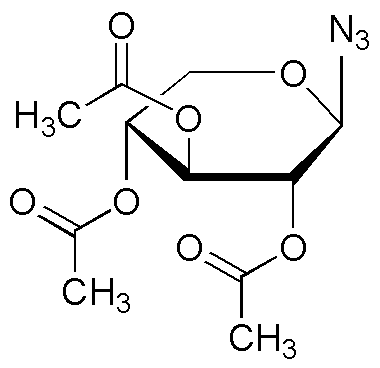2,3,4-Tri-O-acetyl-b-D-xylopyranosyl azide is widely utilized in research focused on:
- Synthetic Chemistry: It serves as a versatile building block in the synthesis of complex carbohydrates and glycosides, enabling researchers to create tailored compounds for various applications.
- Drug Development: This compound is instrumental in the design of glycosylated drugs, which can enhance bioavailability and target specificity, making it valuable in pharmaceutical research.
- Bioconjugation: The azide functional group allows for click chemistry applications, facilitating the attachment of biomolecules to surfaces or other molecules, which is crucial in developing biosensors and targeted therapies.
- Material Science: It can be used in the development of functionalized polymers and materials, providing unique properties for applications in coatings and drug delivery systems.
- Analytical Chemistry: This compound aids in the development of analytical methods for carbohydrate analysis, improving the accuracy and efficiency of research in glycomics.
General Information
Properties
Safety and Regulations
Applications
2,3,4-Tri-O-acetyl-b-D-xylopyranosyl azide is widely utilized in research focused on:
- Synthetic Chemistry: It serves as a versatile building block in the synthesis of complex carbohydrates and glycosides, enabling researchers to create tailored compounds for various applications.
- Drug Development: This compound is instrumental in the design of glycosylated drugs, which can enhance bioavailability and target specificity, making it valuable in pharmaceutical research.
- Bioconjugation: The azide functional group allows for click chemistry applications, facilitating the attachment of biomolecules to surfaces or other molecules, which is crucial in developing biosensors and targeted therapies.
- Material Science: It can be used in the development of functionalized polymers and materials, providing unique properties for applications in coatings and drug delivery systems.
- Analytical Chemistry: This compound aids in the development of analytical methods for carbohydrate analysis, improving the accuracy and efficiency of research in glycomics.
Documents
Safety Data Sheets (SDS)
The SDS provides comprehensive safety information on handling, storage, and disposal of the product.
Product Specification (PS)
The PS provides a comprehensive breakdown of the product’s properties, including chemical composition, physical state, purity, and storage requirements. It also details acceptable quality ranges and the product's intended applications.
Certificates of Analysis (COA)
Search for Certificates of Analysis (COA) by entering the products Lot Number. Lot and Batch Numbers can be found on a product’s label following the words ‘Lot’ or ‘Batch’.
Número de catálogo
Número de lote/lote
Certificates Of Origin (COO)
This COO confirms the country where the product was manufactured, and also details the materials and components used in it and whether it is derived from natural, synthetic, or other specific sources. This certificate may be required for customs, trade, and regulatory compliance.
Número de catálogo
Número de lote/lote
Safety Data Sheets (SDS)
The SDS provides comprehensive safety information on handling, storage, and disposal of the product.
DownloadProduct Specification (PS)
The PS provides a comprehensive breakdown of the product’s properties, including chemical composition, physical state, purity, and storage requirements. It also details acceptable quality ranges and the product's intended applications.
DownloadCertificates of Analysis (COA)
Search for Certificates of Analysis (COA) by entering the products Lot Number. Lot and Batch Numbers can be found on a product’s label following the words ‘Lot’ or ‘Batch’.
Número de catálogo
Número de lote/lote
Certificates Of Origin (COO)
This COO confirms the country where the product was manufactured, and also details the materials and components used in it and whether it is derived from natural, synthetic, or other specific sources. This certificate may be required for customs, trade, and regulatory compliance.


